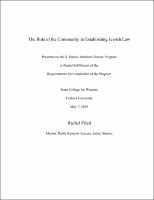Please use this identifier to cite or link to this item:
https://hdl.handle.net/20.500.12202/4470| Title: | The Role of the Community in Establishing Jewish Law. |
| Authors: | Auman, Kenneth Fried, Rachel |
| Keywords: | Jewish community Jewish Law (establishment) senior honors thesis |
| Issue Date: | 7-May-2019 |
| Publisher: | Stern College for Women. Yeshiva University.. |
| Citation: | Fried, Rachel. The Role of the Community in Establishing Jewish Law Presented to the S. Daniel Abraham Honors Program in Partial Fulfillment of the Requirements for Completion of the Program Stern College for Women, Yeshiva University May 7, 2019. |
| Abstract: | Ultimately, Jewish tradition gives the community an important role in shaping Jewish law. Through close analysis of the laws pertaining to the milk, bread, and oil of an idolater, insight can be gleaned as to the full breadth of the community’s role in this capacity—both their powers and their limitations. Communal stringencies, whether additions to rabbinic law or independent customs, have the potential to become binding on future generations, perhaps even on a biblical level. Simultaneously, halakhah looks to protect the community from overly burdensome laws by mandating that rabbis only enact decrees that the majority of Jews can uphold. When laws are unsuccessful at spreading throughout the community, procedure is set for annulling those laws. All of this is done with recognition of the importance of rabbinic leadership and the necessity to protect the authoritative status of rabbis. Thus, the community and the rabbis have a dynamic, interdependent partnership in the forging of rabbinic law. |
| Description: | The file is restricted for YU community access only. |
| URI: | https://hdl.handle.net/20.500.12202/4470 https://ezproxy.yu.edu/login?url=https://repository.yu.edu/handle/20.500.12202/4470 |
| Appears in Collections: | S. Daniel Abraham Honors Student Theses |
Files in This Item:
| File | Description | Size | Format | |
|---|---|---|---|---|
| The Role of the Community in Establishing Jewish Law.pdf Restricted Access | 242.6 kB | Adobe PDF |  View/Open |
This item is licensed under a Creative Commons License

